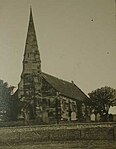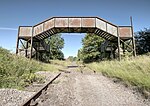Pipehill

Pipehill is a scattered hamlet located between Wall, Staffordshire and Hammerwich in the Lichfield District of Staffordshire, England. The village is mostly consisting of farms, small housing developments and is home to Pipehills Fisheries. There is an hourly bus service that runs through Pipehill from Lichfield to Walsall via Walsall Wood and Aldridge. The nearest railway station is Lichfield City. The now disused South Staffordshire Line ran through Pipehill with a station at Hammerwich. This station closed in 1965 and the line in 2002. Although the section to Brownhills and Walsall was closed in 1984. Pipehill also has a former toll house on Walsall Road which is now in private ownership. The nearest churches is in Wall and Hammerwich.
Excerpt from the Wikipedia article Pipehill (License: CC BY-SA 3.0, Authors, Images).Pipehill
A461, Lichfield
Geographical coordinates (GPS) Address Nearby Places Show on map
Geographical coordinates (GPS)
| Latitude | Longitude |
|---|---|
| N 52.67 ° | E -1.864 ° |
Address
Tollgate Cottage
A461
WS13 8JS Lichfield
England, United Kingdom
Open on Google Maps










